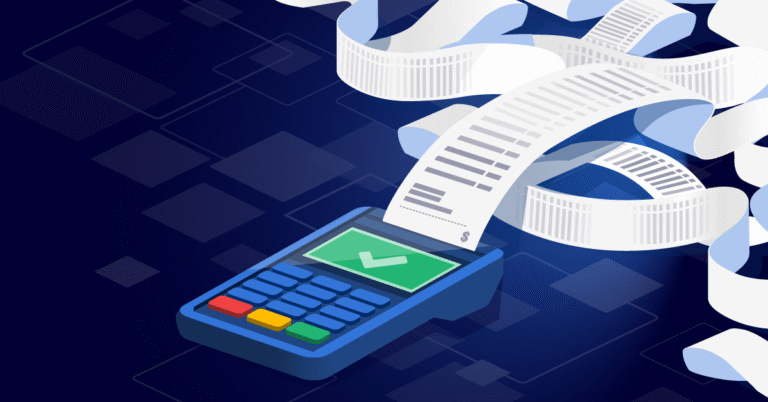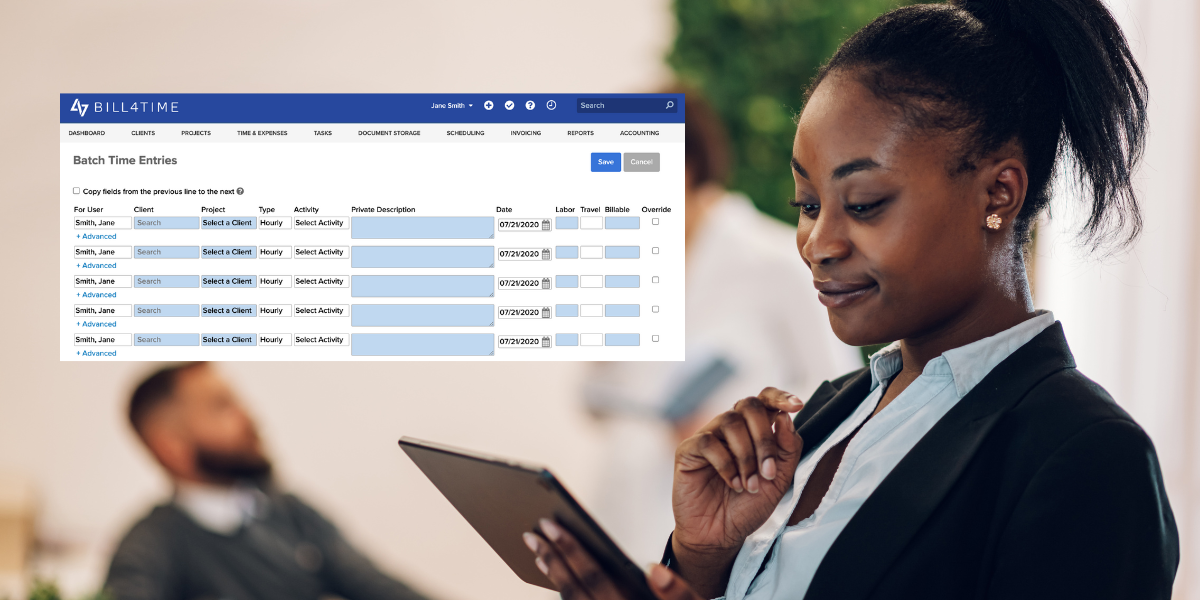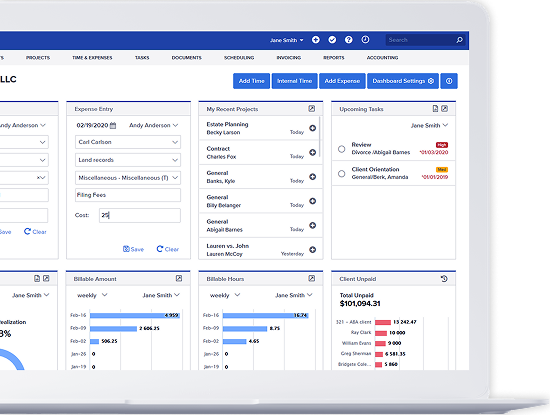
The Attorney Billing Cheat Sheet: Nailing Your Billing Narrative
10/24/2025 By Clare Sheehan
Billing isn’t just about sending invoices—it’s about communicating value. The way you track, describe, and present billable work directly influences how clients perceive your firm, how quickly they pay, and how efficiently your team operates. Yet, billing practices are often treated as an administrative afterthought. In reality, they’re one of the strongest levers for improving productivity and firm growth.
From setting clear billing frameworks to using data-driven reporting in attorney time and billing software, law firms that think critically about their billing strategies are not only more efficient—they’re more profitable and client-centric. This attorney billing cheat sheet will help you refine your billing narrative, improve consistency, and drive better performance across every matter.
Accessing Your Legal Billing Framework
Your billing strategy does more than track hours; it shapes client trust, cash flow, and your firm’s ability to grow. But as client expectations evolve and legal technology raises the bar for convenience, the question isn’t just how much time you spend—it’s “what value do you deliver”? Whether you stick with hourly billing, experiment with alternative fee models, or blend both, the goal is the same: create a system that balances transparency, efficiency, and profitability. Before improving how you bill, you need a clear picture of the system already in place. A legal billing framework defines how time entries are recorded, categorized, and presented to clients. It governs everything from billing increments to the approval process for invoices. Many firms operate with an informal or outdated billing structure—often inherited from a predecessor or formed around habit rather than strategy. That inconsistency can lead to revenue leakage, client disputes, and unnecessary write-downs. To start, take a step back and evaluate how your firm’s billing system functions. When reviewing your setup, focus on these areas:
- Time Capture Methods – Are you logging time contemporaneously? Bill4Time’s built-in timers and mobile capabilities make it easier to record time from anywhere, reducing lost hours and improving accuracy.
- Billing Increments – Are you using the right increments for your practice type? For example, most firms bill in 6-minute increments, but certain practice areas may find 10-minute increments more efficient.
- Approval and Review Process – Does your firm have defined steps for reviewing bills before they’re sent? A second review can help catch vague or incomplete descriptions that might cause client confusion.
- Invoice Presentation – Are invoices clear, detailed, and easy to understand? Clients should immediately see the value of the work performed.
A structured framework doesn’t just prevent billing errors, it creates operational consistency. It ensures every attorney records time uniformly and that the firm’s financial data is clean, comparable, and ready for analysis. As a note, we’ve only covered the basics here, but our comprehensive billing framework guide has everything you need to evaluate your billing approach and achieve meaningful gains in productivity, client satisfaction, and long-term growth. 
Developing Legal Billing Guidelines
Once your billing framework is in place, it’s time to develop formal billing guidelines—the foundation for firm-wide consistency and accountability. Billing guidelines define how attorneys describe work, categorize tasks, and apply the appropriate UTBMS codes (Uniform Task-Based Management System codes). These codes are essential for larger clients, corporate legal departments, or insurance defense matters that require standardized billing.
Why UTBMS Codes Matter
UTBMS codes make billing transparent and measurable. They organize legal services into categories (e.g., research, drafting, client communication) that make it easier to track performance, assess profitability, and benchmark work across matters. For example:
- L110 – Fact Investigation/Development
- L320 – Document Production
- L440 – Discovery Motions
When integrated into attorney billing software like Bill4Time, UTBMS coding can automatically classify tasks, helping firms streamline billing and ensure compliance with client requirements. More importantly, it transforms billing from a static record into a dataset that can drive better decision-making.
Creating Consistent Billing Narratives: Legal Billing Narrative Examples
Beyond codes, every firm should establish language standards for billing narratives—the written descriptions that appear on invoices. These narratives bridge the gap between your internal work and the client’s understanding of what they’re paying for. Vague descriptions like “worked on case” or “reviewed documents” provide little insight into the value delivered. Detailed, action-driven entries help clients see the effort, expertise, and progress behind each billed hour. For example:
- Instead of “Reviewed documents,” write “Reviewed and summarized 25 pages of opposing counsel’s discovery responses to prepare for deposition.”
- Instead of “Client call,” write “Spoke with client regarding next steps in settlement negotiation and strategy for upcoming mediation.”
These kinds of detailed entries show progress, justify costs, and help clients feel confident in your representation. They also protect your firm if invoices are ever questioned or audited.
For Your Reference: Sample Attorney Billing Descriptions
Strong billing narratives don’t just document time—they communicate value. Every line item on an attorney’s billing statement should clearly describe what was done, why it was necessary, and how it supports the client’s goals. Vague or incomplete entries can erode client trust, delay payments, and create unnecessary write-downs. When developing your own internal guide, include:
- Sample time entry templates for common tasks (e.g., client communication, research, drafting).
- Lists of approved terms (e.g., analyzed, negotiated, drafted, reviewed).
- Prohibited language (e.g., “miscellaneous,” “general work,” “other”).
- Guidelines on tone—professional, concise, and descriptive.
Here are several examples of effective legal billing descriptions, categorized by task type:
Client Communication
- “Reviewed client email regarding updated settlement terms; drafted response outlining negotiation strategy.”
- “Prepared and conducted a 30-minute call with the client to review next steps following the court filing.”
Tip: Pair each communication entry with its purpose. Bill4Time’s pre-set activity codes and customizable templates make this easy to standardize across your firm.
Legal Research and Drafting
- “Conducted legal research on state-specific employment classification standards; summarized findings for client memorandum.”
- “Drafted and revised motion to compel discovery responses, incorporating latest case law.”
Why this works: Each entry identifies both the action (“researched,” “drafted”) and the legal objective, helping clients connect your time to a tangible deliverable.
Court Filings and Case Preparation
- “Prepared and filed notice of deposition; coordinated with opposing counsel regarding scheduling.”
- “Reviewed discovery responses and organized evidence for summary judgment motion.”
Bill4Time insight: Use consistent billing increments (such as 0.1-hour) to maintain accuracy and align with firm-wide policies.
Administrative and Case Management
- “Reviewed billing records for accuracy before monthly invoice issuance.”
- “Updated matter status and organized exhibits for upcoming mediation.”
Tip: Even non-billable tasks can provide valuable data for internal reporting. Tracking these entries in Bill4Time’s case management suite supports better time allocation and resource planning. 
Legal Billing Guidelines and the Attorney-Client Relationship
Billing isn’t just a back-office process; it’s part of your client experience. Every invoice you send is an opportunity to communicate value and strengthen trust. When clients receive confusing or opaque invoices, they’re more likely to push back on charges, delay payment, or question your firm’s efficiency. Conversely, when billing is transparent, consistent, and tied to clear outcomes, it reinforces confidence and loyalty. Firms that align billing practices with client expectations see stronger long-term relationships and higher retention rates. Here’s how your billing approach can impact the attorney-client dynamic:
1. Transparency Builds Trust
Clients want to understand how their money is being spent. Clear billing descriptions, standardized increments, and detailed statements show that your firm operates with integrity and professionalism. Bill4Time’s intuitive invoice customization helps firms present information in a client-friendly format—breaking out tasks, matter stages, and even budget comparisons.
2. Consistency Reduces Friction
When every invoice looks different, clients question reliability. Consistency creates predictability, which reduces disputes and accelerates payment cycles. By establishing formal guidelines and using attorney billing software to enforce them, you maintain professionalism across every client interaction.
3. Communication Prevents Disputes
Clients often balk at bills not because of the amount, but because of surprise. By integrating billing discussions into ongoing communication you minimize misunderstandings. Bill4Time’s client portal enables firms to share invoices and updates in real time, ensuring clients always know where things stand.
4. Specificity Drives Loyalty
Billing is also an opportunity for specificity. Tailored summaries that highlight results achieved—like “Filed motion resulting in court granting client’s request for extension”—remind clients of the value you’re delivering. Ultimately, effective billing enhances the attorney-client relationship. It turns invoices into proof of diligence, strategy, and results.
Increasing Legal Billing Efficiency with Metrics and Reporting
Billing is one of the most valuable sources of operational insight a firm can have. Every time entry, adjustment, and invoice tells a story about how your practice functions. Firms that leverage this data can identify inefficiencies, improve forecasting, and strengthen client relationships, all while boosting profitability. Yet many firms still approach billing reactively, focusing solely on getting invoices out the door. Billing software like Bill4Time transforms that process into a performance engine that tracks, measures, and refines how your firm works. With Bill4Time’s advanced reporting suite, firms can access granular insights into:
- Billable vs. non-billable hours to pinpoint where time is being lost and where efficiency can improve.
- Collection rates and outstanding balances to strengthen cash flow management and identify at-risk accounts before they become revenue problems.
- Attorney utilization and realization metrics, allowing managing partners to see which practice areas or team members are driving profitability and which may need support or resource reallocation.
Integrating metrics into your billing process also helps firms move from reactive to proactive management. For example, by analyzing time entry trends, you may discover that routine administrative tasks are consuming excessive billable time. That insight can justify workflow automation or delegation decisions that yield immediate productivity gains. Transparency is another advantage. When clients receive clear, well-structured invoices supported by accurate billing data, they’re more likely to trust the process and pay promptly. Bill4Time’s client portal further enhances this experience by providing clients with secure, on-demand access to invoices and online payment options—reducing friction in the billing cycle. Ultimately, firms that consistently measure and optimize billing performance position themselves for sustainable growth.
Billing With Confidence
Mastering your billing narrative isn’t just about cleaner invoices—it’s about transforming billing into a strategic asset that drives growth. When your firm’s billing framework, guidelines, and metrics align, you gain more than operational efficiency—you gain insight.
- A structured billing framework ensures time is captured consistently and accurately.
- Formal billing guidelines improve transparency, reduce disputes, and standardize quality.
- Meaningful billing narratives help clients understand and appreciate your value.
- Robust reporting and metrics turn billing into a business intelligence function.
Together, these elements create a self-reinforcing cycle: clear billing builds trust, trust drives retention, and retention fuels profitability. Beyond reporting, Bill4Time’s task management capabilities help firms accelerate the invoicing process while maintaining precision and professionalism. Customizable invoices, automated time capture, and legal calendaring save hours each month—time that can be reinvested in client work or business development. Law firms that invest in better billing practices aren’t just getting paid faster—they’re positioning themselves for long-term growth. And with Bill4Time, your firm can streamline billing, enhance visibility, and take control of its narrative, one time entry at a time.



